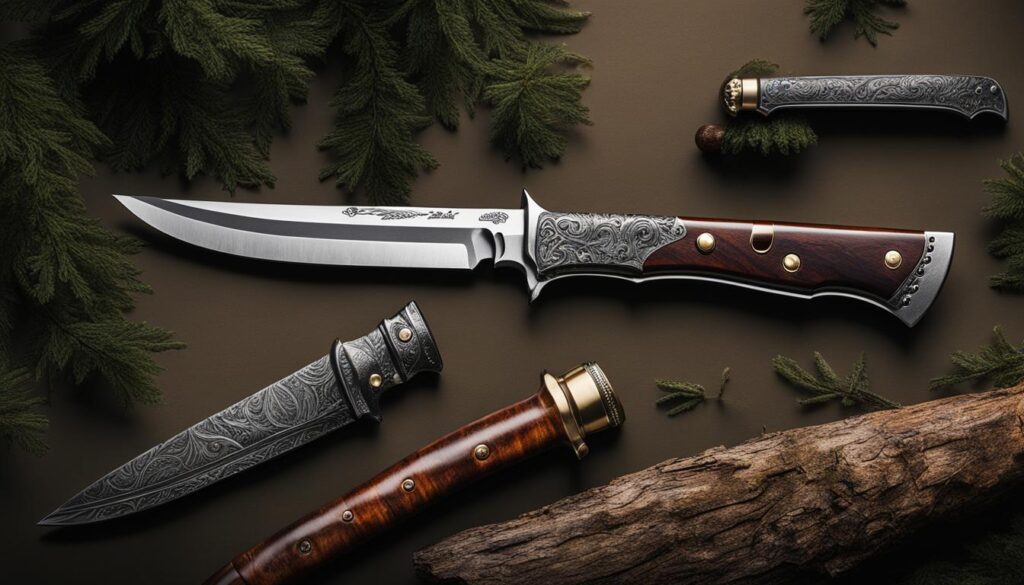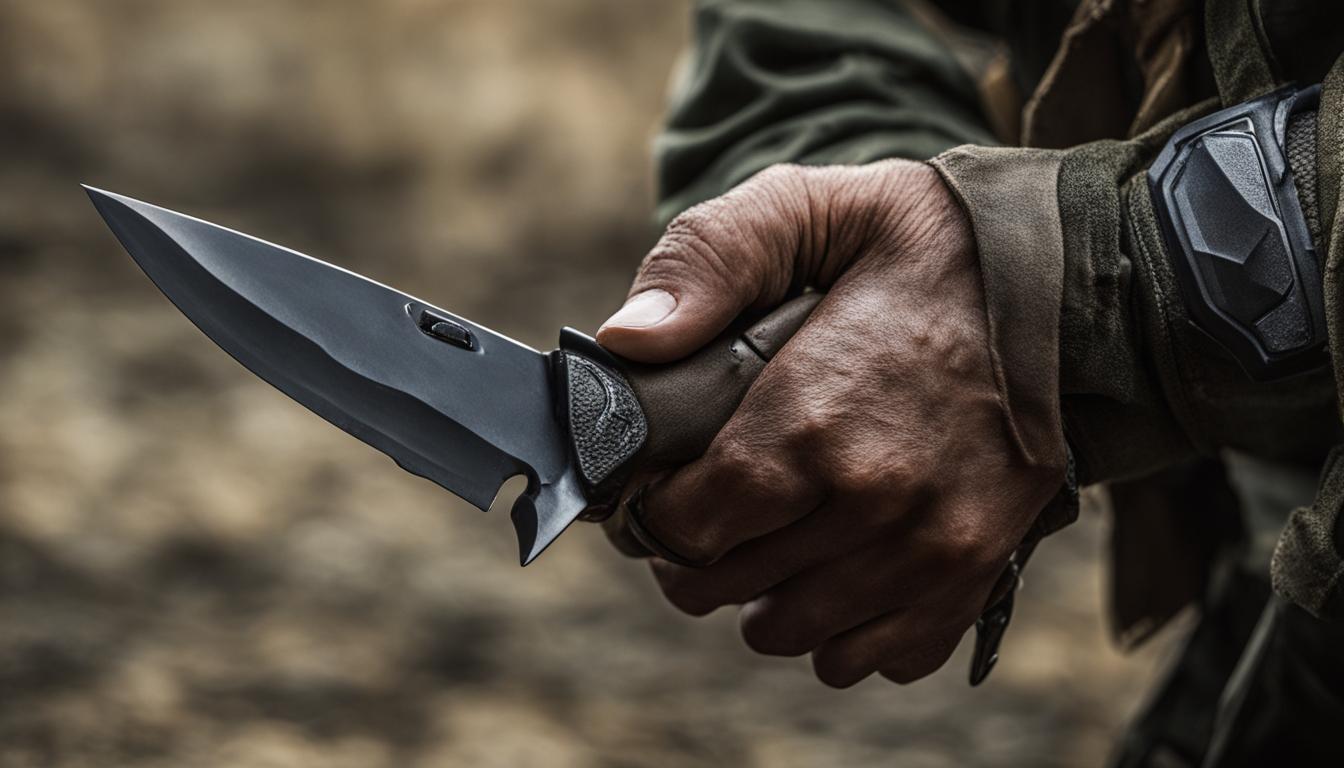When it comes to hunting, having the right equipment is essential for a successful and efficient experience. One crucial tool every hunter needs is a reliable and well-suited hunting knife. But what is the optimal size for a hunting knife? How can you ensure that you are choosing the perfect fit for your hunting needs? In this article, I will explore the factors that determine the ideal hunting knife size, from blade length to handle ergonomics and balance. By understanding these factors, you can make an informed decision and maximize your hunting performance.
Key Takeaways:
- Choosing the optimal hunting knife size is vital for a successful hunt.
- Factors such as blade length, handle ergonomics, and balance impact the performance of a hunting knife.
- Blade shape, handle material, and steel composition are additional factors to consider when selecting a hunting knife.
- Recommended hunting knife brands include Kershaw, Spyderco, Gerber, Buck, and Knives of Alaska.
- Invest time in researching and handling different knives to find the perfect fit that will enhance your hunting game.
Factors to Consider When Choosing a Hunting Knife
When it comes to selecting the perfect hunting knife, several factors need to be taken into consideration. These factors play a crucial role in determining the optimal size of the knife and can greatly impact your hunting experience. Let’s delve into the key factors that should be evaluated when choosing a hunting knife.
Blade Shape
The shape of the blade is an important factor to consider when selecting a hunting knife. Different blade shapes offer varying levels of practicality for outdoor activities. Two popular blade shapes for hunting knives are the drop-point and skinner blades. The drop-point blade is versatile and provides excellent control, making it suitable for a wide range of tasks such as field dressing and skinning game. On the other hand, the skinner blade is specifically designed for skinning animals and features a curved edge that makes it easier to navigate through tough hides.
Blade Length
Blade length is another crucial factor to consider. The optimal blade length largely depends on the specific hunting tasks you expect to perform. Knives with blades that are too long can be unwieldy and increase the risk of accidents. It’s generally recommended to avoid blades longer than four inches for hunting purposes. A shorter blade length ensures better maneuverability and control. However, it’s important to strike a balance as a blade that is too short may not be effective for certain tasks such as field dressing larger game.
Handle Ergonomics
The ergonomics of the handle play a vital role in the overall comfort and safety of using a hunting knife. Consider the material and shape of the handle when making your selection. The handle should provide a secure grip to prevent accidents and fatigue. Different handle materials offer varying levels of grip and durability. While antler or bone handles may be visually appealing, they can become slippery when wet. Wood handles offer better grip when wet, but they may be more prone to cosmetic damage. Plastic handles are lightweight, affordable, and often come with textured surfaces for enhanced grip. Rubber inserts can also be added to provide additional traction.
Balance
The balance of a hunting knife affects how it feels and handles during use. Achieving the right balance involves considering factors such as blade length, thickness, handle material, and weight distribution. Many hunters prefer a weight-forward balance as it improves control and maneuverability. It’s important to handle different knives and assess their balance to find the one that feels comfortable and balanced in your hand.
| Factors to Consider | Blade Shape | Blade Length | Handle Ergonomics | Balance |
|---|---|---|---|---|
| Definition | The practicality of the knife | Ensuring easy handling, avoiding accidents | Secure grip, preventing accidents and fatigue | Overall feel and maneuverability |
| Examples | Drop-point, skinner blades | Avoid blades longer than four inches | Material and shape of the handle | Weight-forward balance for improved control |
The Importance of Steel in Hunting Knife Performance
When it comes to hunting knife performance, the type of steel used in the blade plays a critical role. Steel composition determines the knife’s durability, edge retention, and resistance to corrosion. Understanding the different types of steel and their properties can help you choose a hunting knife that meets your specific needs.
One common type of steel used in hunting knives is stainless steel. Stainless steel offers good corrosion resistance and edge retention, making it a popular choice among hunters. Some popular stainless steel options include 440C, VG-10, and 154CM/ATS-34, each with its own advantages in terms of hardness and wear resistance.
Another option is carbon steel, which is known for its ability to be hardened to higher levels without compromising strength. Carbon steel knives can hold a sharp edge for extended periods, making them ideal for heavy-duty tasks. Common carbon steel options used in knife-making include O1, A2, and D2.
Ultimately, the choice between stainless steel and carbon steel comes down to personal preference and the specific demands of your hunting activities. Consider the intended use, maintenance requirements, and desired performance characteristics when selecting the steel composition for your hunting knife.

Choosing the Right Blade Length for Hunting
When it comes to choosing a hunting knife, the blade length plays a crucial role in determining its practicality and overall performance. The optimal blade length depends on the specific hunting tasks you expect to undertake. A blade that is too long can be unwieldy and increase the risk of accidents, while a blade that is too short may not provide enough cutting power.
It is generally recommended to avoid knives with blades longer than four inches for most hunting purposes. This length strikes a balance between ease of handling and cutting efficiency. However, it’s important to consider factors such as the type of game you will be hunting and the specific tasks you will be performing. Different hunting scenarios may require slightly longer or shorter blade lengths.


The Benefits of Full-Tang Blades
When choosing a hunting knife, another factor to consider is whether the blade is full-tang or not. A full-tang blade refers to a knife where the steel of the blade extends through the entire length of the handle. This design offers superior strength and durability, making it a popular choice among hunters.
In addition to providing enhanced strength, full-tang blades also offer better balance and control. The longer tang provides additional cutting power, allowing for more efficient and effective field dressing and game processing. This added strength and functionality make full-tang blades a preferred choice for many hunters.
In conclusion, choosing the right blade length is crucial for a hunting knife that meets your specific needs. Consider the type of game you will be hunting and the tasks you will perform, and aim for a blade length that strikes a balance between ease of handling and cutting efficiency. Additionally, opt for a full-tang blade design to ensure superior strength, durability, and overall functionality.
Hunting Knife Handle Ergonomics and Materials
When it comes to choosing a hunting knife, the ergonomics of the handle play a vital role in ensuring a secure grip and comfortable usage. A well-designed handle allows for better control, reduces hand fatigue, and minimizes the risk of accidents. Additionally, the choice of handle materials can significantly impact the overall performance and durability of the knife. Let’s explore some common handle materials and their characteristics:
Antler or Bone Handles
Antler or bone handles can add a unique aesthetic appeal to a hunting knife. However, it’s important to note that these natural materials can become slippery when wet, compromising the grip. They may require regular maintenance, such as oiling, to prevent drying out or cracking.
Wood Handles
Wood handles are a popular choice among hunters due to their natural beauty and excellent grip, even when wet. However, it’s worth noting that wood handles are more prone to cosmetic damage compared to other materials. Regular oiling and maintenance can help preserve the wood and extend its lifespan.
Plastic Handles
Plastic handles are lightweight, affordable, and often offer good grip. They are particularly suitable for hunters who prefer a low-maintenance option. Some plastic handles also feature textured surfaces, further enhancing the grip, especially in wet or slippery conditions.
Rubber Inserts and Textured Surfaces
To improve traction and grip, some hunting knives feature rubber inserts or textured surfaces on the handle. These additional features can be particularly useful during messy tasks or adverse weather conditions, providing a secure and comfortable grip.
| Handle Material | Pros | Cons |
|---|---|---|
| Antler or Bone | Unique, visually appealing | Can become slippery when wet, requires maintenance |
| Wood | Natural beauty, excellent grip | Prone to cosmetic damage, requires regular maintenance |
| Plastic | Lightweight, affordable, good grip | May lack the same tactile feel as other materials |
| Rubber Inserts and Textured Surfaces | Enhanced grip, especially in wet or slippery conditions | Dependent on the quality of the inserts or texture |
“The choice of handle material should be based on your personal preferences, as well as the specific hunting conditions you anticipate. Consider factors such as maintenance requirements, grip performance, and overall durability when selecting the ideal handle material for your hunting knife.”
By carefully considering handle ergonomics and materials, you can ensure that your hunting knife provides the comfort and control you need for a successful hunting experience. Remember to choose a handle that fits your hand well, enhances grip in different conditions, and meets your personal preferences for aesthetics and maintenance requirements.
Achieving the Right Balance for a Controlled Knife
When it comes to hunting knives, achieving the right balance is crucial for optimal performance in the field. Balance is influenced by several factors, including blade length and thickness, handle material, and weight distribution. Finding the perfect balance ensures that the knife feels comfortable in your hand and allows for controlled and precise movements during use.
Blade length and thickness play a significant role in determining the balance of a hunting knife. Longer blades tend to shift the knife’s center of gravity forward, creating a weight-forward balance. This balance is preferred by many hunters as it provides better control and maneuverability. On the other hand, shorter blades can result in a handle-heavy balance, which may feel less comfortable and affect overall performance.
The handle material of a hunting knife also impacts its balance. Different handle materials have varying densities, which can affect the weight distribution. For example, a knife with a handle made of dense hardwood will have a different balance compared to one with a lightweight plastic handle. It’s important to consider your personal preference and the intended use of the knife when choosing the handle material.
Weight distribution is another crucial factor in achieving the right balance. Ideally, the weight should be evenly distributed between the blade and the handle. This allows for a natural and comfortable grip while providing the necessary weight for controlled cutting and slicing motions. Handling different knives and assessing their balance is essential to finding the right knife that feels balanced and comfortable in your hand.
Overall, achieving the right balance in a hunting knife is essential for a controlled and efficient cutting experience. Consider the blade length and thickness, handle material, and weight distribution to find a knife that offers the perfect balance for your needs. Remember to test and handle different knives to determine the balance that feels most comfortable and allows for precise and controlled movements in the field.
Recommended Hunting Knives for Optimal Performance
When it comes to choosing the right hunting knife, there are several reputable brands known for their quality and performance. These knives have been tested under rigorous conditions and are highly recommended for hunters seeking optimal performance and reliability in the field. Whether you’re looking for a reliable fixed blade or a versatile folding knife, these brands offer a range of options to suit different hunting needs.
Here are some of the best hunting knife brands that hunters trust:
- Kershaw: Known for their innovative designs and high-quality craftsmanship, Kershaw knives are favored by many hunters. The Kershaw Echo, with its durable stainless steel blade and comfortable handle, is a popular choice for its reliability and functionality.
- Spyderco: Spyderco knives are renowned for their excellent build quality and ergonomic designs. The Spyderco Bill Moran FB01, featuring a full-tang blade and a comfortable handle, offers exceptional cutting performance and durability.
- Gerber: Gerber knives are trusted by hunters for their ruggedness and practicality. The Gerber Longbow, with its fixed blade design and grippy handle, is a versatile choice for various hunting tasks.
- Buck: Buck knives have a long-standing reputation for their legendary durability and craftsmanship. The Buck’s Folding Alpha Hunter 277 is a folding knife with a robust blade and a reliable lock mechanism, making it ideal for hunters who prefer a compact and portable option.
- Knives of Alaska: Knives of Alaska specializes in crafting high-quality knives for outdoor enthusiasts. The Knives of Alaska Elk Hunter, designed specifically for big game hunting, offers superb edge retention and overall performance in the field.
These recommended hunting knives are known for their quality, functionality, and value for money. Whether you’re a seasoned hunter or just starting out, investing in a reliable hunting knife from one of these brands can greatly enhance your hunting experience. Remember to choose a knife that suits your specific needs and preferences, considering factors such as blade type, handle material, and overall design. With the right hunting knife in your arsenal, you’ll be well-equipped for a successful hunt.
| Brand | Recommended Model | Key Features |
|---|---|---|
| Kershaw | Echo | Durable stainless steel blade, ergonomic handle |
| Spyderco | Bill Moran FB01 | Full-tang blade, comfortable handle |
| Gerber | Longbow | Fixed blade design, grippy handle |
| Buck | Folding Alpha Hunter 277 | Robust blade, reliable lock mechanism |
| Knives of Alaska | Elk Hunter | Superb edge retention, designed for big game hunting |
Conclusion
Choosing the right hunting knife is crucial to ensure a successful hunt. By considering factors such as optimal hunting knife size, blade length and ergonomics, handle materials, and balance, you can find a knife that meets your specific needs.
When it comes to size, it’s important to select the optimal hunting knife size that offers ease of handling and effectiveness in field dressing and skinning game. The right blade length, shape, and handle ergonomics contribute to the practicality and functionality of the knife during outdoor activities.
Additionally, the type of steel used in the knife’s construction greatly affects its performance, with stainless steel and carbon steel being popular choices. Understanding the different steel compositions and blade hardness can help you make an informed decision.
To maximize handle ergonomics and ensure a secure grip, consider factors such as handle materials, such as wood, plastic, or rubber inserts, and textured surfaces. Finally, achieving the right balance between blade length, thickness, handle material, and weight distribution is essential for a controlled knife.
Remember, selecting the optimal hunting knife involves personal preference and requires research and hands-on testing. Take the time to find the perfect fit, and you’ll be equipped with a hunting knife that enhances your hunting experience.
FAQ
What factors should I consider when choosing a hunting knife?
When choosing a hunting knife, it’s important to consider factors such as blade shape, blade length, handle ergonomics, and balance.
What types of steel are commonly used in hunting knives?
Stainless steel and carbon steel are commonly used in hunting knives. Each has its own advantages in terms of corrosion resistance, edge retention, and hardness.
What is the optimal blade length for a hunting knife?
The optimal blade length depends on the specific hunting tasks you expect to perform. Generally, it is recommended to avoid knives with blades longer than four inches.
Are full-tang blades better for hunting?
Knives with full-tang blades, where the steel extends through the handle, offer superior strength and durability.
What materials are best for hunting knife handles?
The best materials for hunting knife handles depend on personal preference and factors such as grip, wet conditions, and durability. Some common handle materials include antler or bone, wood, plastic, and rubber inserts.
How does balance affect a hunting knife?
Balance, influenced by factors such as blade length, thickness, handle material, and weight distribution, affects how a hunting knife feels and performs during use.
Can you recommend any hunting knife brands?
Some recommended hunting knife brands include Kershaw, Spyderco, Gerber, Buck, and Knives of Alaska. These brands are known for their quality, durability, and functionality.





